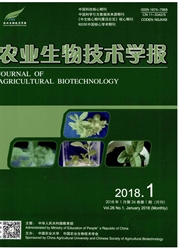

 中文摘要:
中文摘要:
光唇鱼(Acrossocheilus fasciatus)是我国溪流性特色经济鱼类之一,因生境变化及捕捞过度等原因,导致种质资源衰退,因此需要开展种质资源保护及种质细胞保存研究,精子冷冻保存是种质细胞保存的有效方式之一。本研究,从人工养殖的性成熟雄性光唇鱼采集精液,以0.25 mL麦细管为冻存管,开展稀释液及其稀释比例、抗冻剂种类及其浓度、平衡时间、两步降温法降温高度以及解冻温度等对该种鱼精子超低温冻存效果影响的研究,并通过酶活性检测对冻精质量进行初步评价。结果表明,在稀释液为D-15液、稀释比为1∶5、抗冻剂为10%二甲基亚砜(dimethyl sulfoxide, DMSO)、平衡时间为30 min,距离液氮面3.5 cm处降温5 min后投入液氮中保存以及37 ℃解冻的精子效果较佳,冻精解冻后激活率达(35.33±2.52)%,但与鲜精激活率(87.67±3.06)%相比仍差异显著(P<0.05);鲜精总ATP酶、琥珀酸脱氢酶(succinate dehydrogenase, SDH)及乳酸脱氢酶(lactate dehydrogenase, LDH)活性分别为(9.31±0.17) U/mL、(30.33±5.69) U/mL和(7 454.84±252.42) U/L,冻精总ATP酶、SDH和LDH活性分别为(7.23±1.08) U/mL、(17.67±6.03) U/mL和(2 172.48±209.62) U/L,两者差异亦显著(P<0.05)。本研究取得了光唇鱼精子冷冻保存实验的初步成功,为光唇鱼精子冷冻保存库建立提供了一定的技术基础,但有关技术参数还有待于进一步探索优化,以提高冻精质量。
 英文摘要:
英文摘要:
Acrossocheilus fasciatus is a type of stream fish having great economic value in China. Recently, resource of A. fasciatus has declined rapidly due to overfishing and habitat destruction. Sperm cryopreservation is an effective way to protect germ cells; therefore, research in germplasm resource protection and germ cell conservation are in urgent need. In this study, the sperm was collected from cultured mature male fish and was stored in 0.25 mL straws for the study of sperm cryopreservation. Different conditions were evaluated for sperm cryopreservation, including extenders (Kurokura-1, Ringer, Cortland, D-14, D-15, D-16, D-17, D-19, D-20 and D-21), dilution ratios (1∶1, 1∶2, 1∶3, 1∶4, 1∶5, 1∶7 and 1∶9), cryoprotectants (dimethyl sulfoxide (DMSO), methyl alcohol (MeOH), ethylene glycol (EG), and propylene glycol (PG)), equilibrium times (0, 10, 20, 30, 40, 50 and 60 min), cooling heights (using two-step cooling procedures) (2, 3.5, 5, 6.5 and 8 cm), and thawing temperatures (27, 32, 37, 40 and 42 ℃). In addition, we detected the quality of fresh and corresponding frozen-thawed sperm through their enzyme activities. The experimental data were expressed as X±SD, using SPSS 17.0 statistical software. The statistically significant differences in sperm activation rate and enzyme activities of each group were detected by one-way ANOVA. P〈0.05 were considered significant. The fresh sperm density of Acrossocheilus fasciatus was (9.32±2.03)×109 cells/mL. The optimum result was obtained with the cryoprotectant comprising D-15 diluted with 10% DMSO, which was mixed with sperm at a ratio of 1∶5, equilibrated for 30 min, swung at 3.5 cm above nitrogen for 5 min, and finally stored in nitrogen. After thawing in a water bath at 37 ℃, the activation rate of the frozen-thawed sperm was (35.33±2.52)%; meanwhile, the rate of fresh sperms was (87.67±3.06)%. Enzyme activities were examined using reagent kits. Compared to the fresh sperm, the activitie
 同期刊论文项目
同期刊论文项目
 同项目期刊论文
同项目期刊论文
 期刊信息
期刊信息
